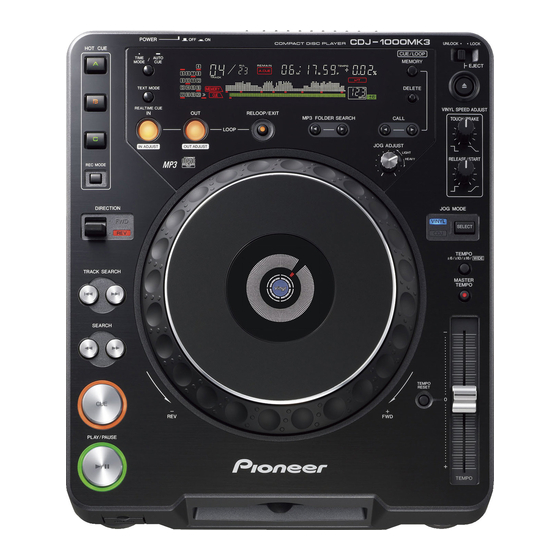Pioneer CDJ 1000MK3 - Professional CD/MP3 Turntable 사용 설명서 - 페이지 20
{카테고리_이름} Pioneer CDJ 1000MK3 - Professional CD/MP3 Turntable에 대한 사용 설명서을 온라인으로 검색하거나 PDF를 다운로드하세요. Pioneer CDJ 1000MK3 - Professional CD/MP3 Turntable 24 페이지. Cd player
Pioneer CDJ 1000MK3 - Professional CD/MP3 Turntable에 대해서도 마찬가지입니다: 사용 설명서 (34 페이지), 사용 설명서 (35 페이지)

Operations Using Memory Cards
Operations Using Memory Cards
I Using memory cards
This player supports the use of SD memory cards or MultiMedia Cards
for the recording of disc identification data, cue point data, loop point
data, and hot cue data.
# SD memory cards must be formatted in accordance with "SD
Memory Card Specifications Part2 FILE SYSTEM SPECIFICATION
Version 1.0" (commercially purchased SD memory cards are fac-
tory formatted to the above standards). Unformatted cards can-
not be used (the [UNFORMAT] message will be displayed).
# Memory cards formatted on computers or in digital cameras
may not be usable with this player.
# MultiMedia Cards (MMC) formatted on the CDJ-1000 or CDJ-
1000MK2 have the following limitations:
¶ MP3 data cannot be recorded.
¶ Loop data set in hot cues cannot be recorded.
¶ It is not possible to use a computer to copy or backup the
cards.
¶ When recording loop points, a single loop point requires
two points of memory area.
¶ The cards cannot be reformatted in this unit.
To protect important data (SD memory card)
Rear view
¶ Set the write-protect switch to the [LOCK] position to prevent fur-
ther writing to the card. Return the switch to its original position if
you wish to record further data on the card.
I Loading a memory card
Memory
CARD indicator
Label
surface up
Open the memory card door, and insert the memory card, label side up
and with the beveled edge toward the front. Insert the card slowly, hold-
ing it flat, and push it in until it stops. Shut the memory card door.
The display will show [SD CARD] (for cards conforming to the SD memory
card standard) or [CDJ CARD] (for cards formatted with the CDJ-1000 or
CDJ-1000MK2), followed by the number of discs recorded on the card.
¶ Removing the memory card
Open the memory card door and wait until the CARD indicator lamp
goes out, then press in the memory card slightly and allow it to eject;
grasp the end of the card and pull out carefully.
20
Write-protect switch
Memory card
Memory card door
Notes:
¶ Do not open the card door or turn off power while the CARD
indicator is flashing, since the recorded data may be damaged.
¶ Memory cards are precision electronic devices. Do not bend or
drop them, or subject them to strong forces or impacts. Also,
avoid using or storing memory cards in environments subject
to static electricity or electrical noise.
¶ Memory cards can be broken when subjected to impacts or
static electricity. Be very careful when handling them, and make
regular backups of important recorded data ( P. 21).
Pioneer disclaims any responsibility for damage to or loss of
memory card data, or other incidental damages arising from
such loss.
Recording to memory cards
¶ Up to 100 points (total of both cue and loop points) can be stored for
each disc. When 100 points have been stored, attempts to record
further points will result in the display of the [POINT FULL] message,
and no further points can be recorded.
¶ If insufficient memory space exists on the card to record the current
points, the [CARD FULL] message will appear.
¶ If the card has been set to write-protect, the [CARD PROTECTED]
message will be displayed.
I Recording a cue point
1. Use the auto cue function or CUE button to input a cue
point.
2. Press the CUE/LOOP MEMORY button.
¶ The display will show the cue point position data, and the word
[CARD MEMORY] will appear in the display, indicating that the
cue point has been stored in the memory card.
¶ If no memory card is loaded, the [NO CARD] message will appear.
¶ If the memory card door is open without any memory card being
loaded, the message [CLOSE CARD DOOR] will appear in the
display.
I Recording a loop point
1. Set a loop-in point and loop-out point and begin loop play-
back.
2. During loop playback, press the CUE/LOOP MEMORY but-
ton.
¶ The display will show the cue point position data, and the word
[CARD MEMORY] will appear in the display, indicating that the
loop-in and loop-out points have been stored in the memory card.
¶ If no memory card is loaded, the [NO CARD] message will appear.
¶ If the memory card door is open without any memory card being
loaded, the message [CLOSE CARD DOOR] will appear in the
display.
I Recording hot cue points A, B, C
Hot cue points A, B, and C are automatically recorded on the memory
card.
CUE/LOOP
MEMORY
CUE/LOOP
DELETE
CUE/LOOP
CALL
2, 3
